Bloom Syndrome: Genetic Disorder, Pedigree and Report Coursework
VerifiedAdded on 2023/06/17
|6
|915
|61
Report
AI Summary
This assignment solution provides a comprehensive overview of Bloom Syndrome, a rare autosomal recessive genetic disorder characterized by a predisposition to cancer, short stature, and genomic instability due to mutations in the BLM gene. The report discusses the population frequency, major causative genetic changes, and molecular abnormalities associated with the syndrome, along with its inheritance patterns and mechanistic basis. It details the symptoms of Bloom Syndrome, including skin changes, growth deficiencies, and increased cancer risk, and outlines current treatment strategies focused on managing symptoms, preventing infections, and early cancer detection. A pedigree diagram is included to illustrate the inheritance pattern within a family. The report concludes by summarizing the genetic complexities and clinical management of Bloom Syndrome.
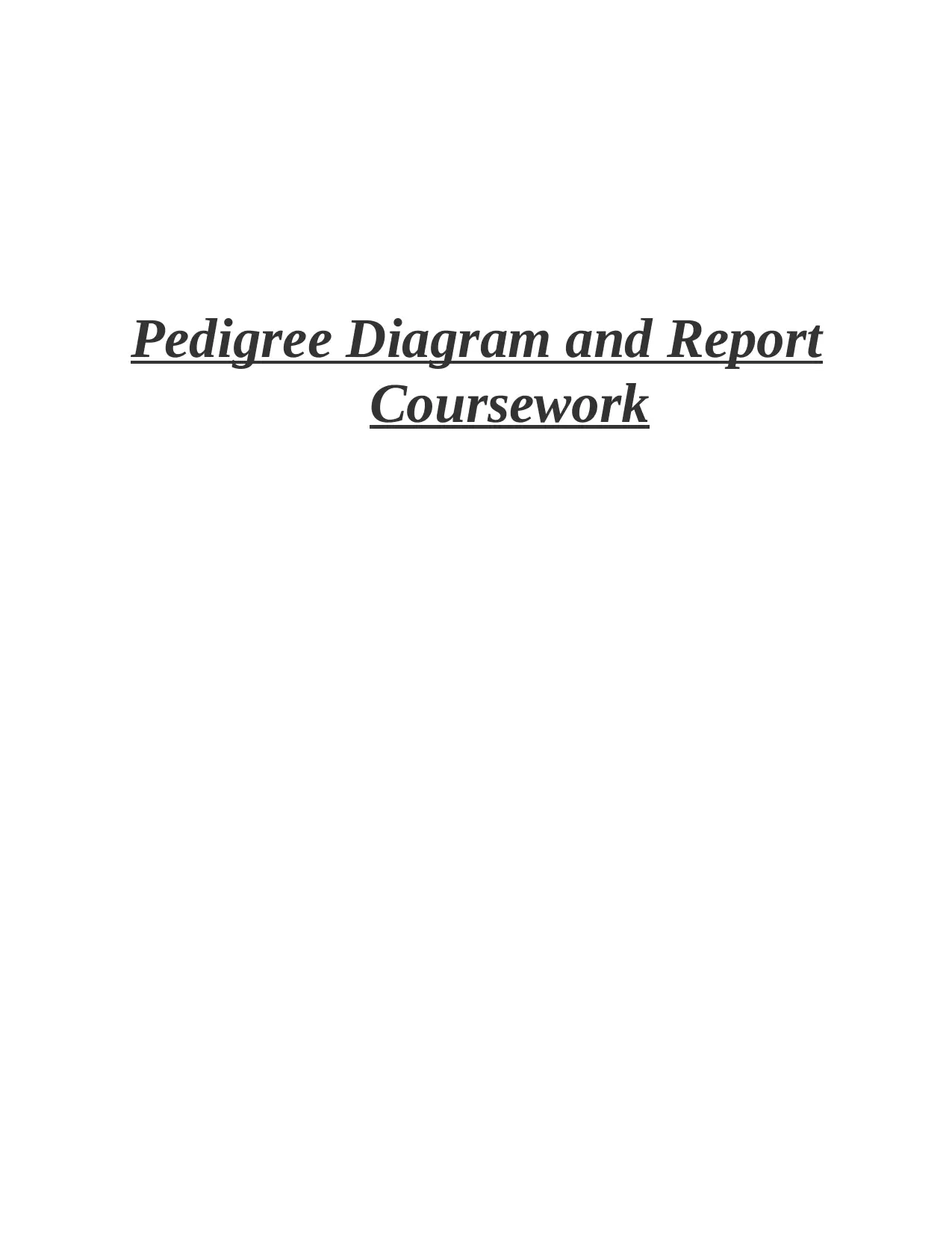
Pedigree Diagram and Report
Coursework
Coursework
Paraphrase This Document
Need a fresh take? Get an instant paraphrase of this document with our AI Paraphraser

Table of Contents
TASK 1............................................................................................................................................3
TASK 2............................................................................................................................................4
REFERENCES................................................................................................................................5
TASK 1............................................................................................................................................3
TASK 2............................................................................................................................................4
REFERENCES................................................................................................................................5
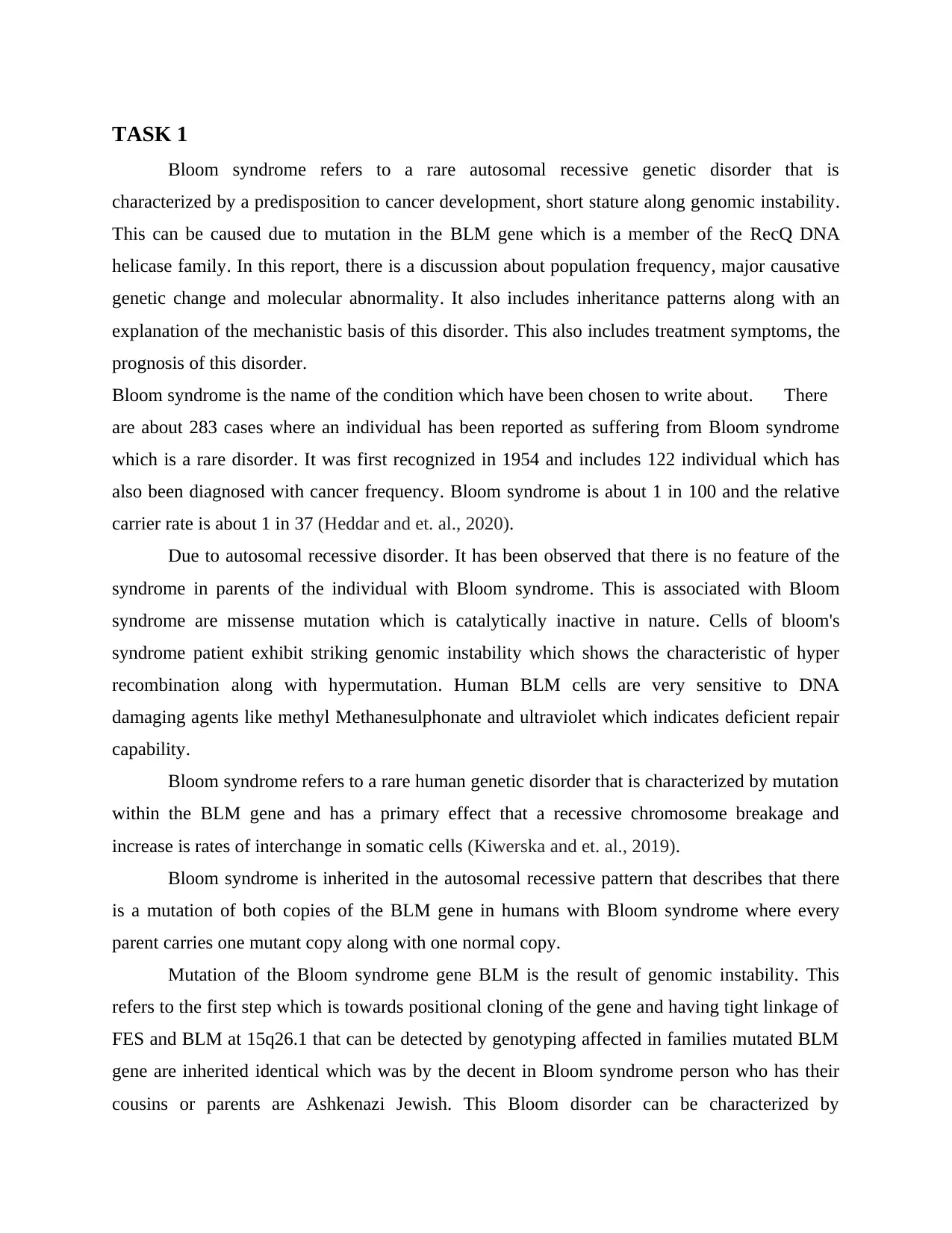
TASK 1
Bloom syndrome refers to a rare autosomal recessive genetic disorder that is
characterized by a predisposition to cancer development, short stature along genomic instability.
This can be caused due to mutation in the BLM gene which is a member of the RecQ DNA
helicase family. In this report, there is a discussion about population frequency, major causative
genetic change and molecular abnormality. It also includes inheritance patterns along with an
explanation of the mechanistic basis of this disorder. This also includes treatment symptoms, the
prognosis of this disorder.
Bloom syndrome is the name of the condition which have been chosen to write about. There
are about 283 cases where an individual has been reported as suffering from Bloom syndrome
which is a rare disorder. It was first recognized in 1954 and includes 122 individual which has
also been diagnosed with cancer frequency. Bloom syndrome is about 1 in 100 and the relative
carrier rate is about 1 in 37 (Heddar and et. al., 2020).
Due to autosomal recessive disorder. It has been observed that there is no feature of the
syndrome in parents of the individual with Bloom syndrome. This is associated with Bloom
syndrome are missense mutation which is catalytically inactive in nature. Cells of bloom's
syndrome patient exhibit striking genomic instability which shows the characteristic of hyper
recombination along with hypermutation. Human BLM cells are very sensitive to DNA
damaging agents like methyl Methanesulphonate and ultraviolet which indicates deficient repair
capability.
Bloom syndrome refers to a rare human genetic disorder that is characterized by mutation
within the BLM gene and has a primary effect that a recessive chromosome breakage and
increase is rates of interchange in somatic cells (Kiwerska and et. al., 2019).
Bloom syndrome is inherited in the autosomal recessive pattern that describes that there
is a mutation of both copies of the BLM gene in humans with Bloom syndrome where every
parent carries one mutant copy along with one normal copy.
Mutation of the Bloom syndrome gene BLM is the result of genomic instability. This
refers to the first step which is towards positional cloning of the gene and having tight linkage of
FES and BLM at 15q26.1 that can be detected by genotyping affected in families mutated BLM
gene are inherited identical which was by the decent in Bloom syndrome person who has their
cousins or parents are Ashkenazi Jewish. This Bloom disorder can be characterized by
Bloom syndrome refers to a rare autosomal recessive genetic disorder that is
characterized by a predisposition to cancer development, short stature along genomic instability.
This can be caused due to mutation in the BLM gene which is a member of the RecQ DNA
helicase family. In this report, there is a discussion about population frequency, major causative
genetic change and molecular abnormality. It also includes inheritance patterns along with an
explanation of the mechanistic basis of this disorder. This also includes treatment symptoms, the
prognosis of this disorder.
Bloom syndrome is the name of the condition which have been chosen to write about. There
are about 283 cases where an individual has been reported as suffering from Bloom syndrome
which is a rare disorder. It was first recognized in 1954 and includes 122 individual which has
also been diagnosed with cancer frequency. Bloom syndrome is about 1 in 100 and the relative
carrier rate is about 1 in 37 (Heddar and et. al., 2020).
Due to autosomal recessive disorder. It has been observed that there is no feature of the
syndrome in parents of the individual with Bloom syndrome. This is associated with Bloom
syndrome are missense mutation which is catalytically inactive in nature. Cells of bloom's
syndrome patient exhibit striking genomic instability which shows the characteristic of hyper
recombination along with hypermutation. Human BLM cells are very sensitive to DNA
damaging agents like methyl Methanesulphonate and ultraviolet which indicates deficient repair
capability.
Bloom syndrome refers to a rare human genetic disorder that is characterized by mutation
within the BLM gene and has a primary effect that a recessive chromosome breakage and
increase is rates of interchange in somatic cells (Kiwerska and et. al., 2019).
Bloom syndrome is inherited in the autosomal recessive pattern that describes that there
is a mutation of both copies of the BLM gene in humans with Bloom syndrome where every
parent carries one mutant copy along with one normal copy.
Mutation of the Bloom syndrome gene BLM is the result of genomic instability. This
refers to the first step which is towards positional cloning of the gene and having tight linkage of
FES and BLM at 15q26.1 that can be detected by genotyping affected in families mutated BLM
gene are inherited identical which was by the decent in Bloom syndrome person who has their
cousins or parents are Ashkenazi Jewish. This Bloom disorder can be characterized by
⊘ This is a preview!⊘
Do you want full access?
Subscribe today to unlock all pages.

Trusted by 1+ million students worldwide
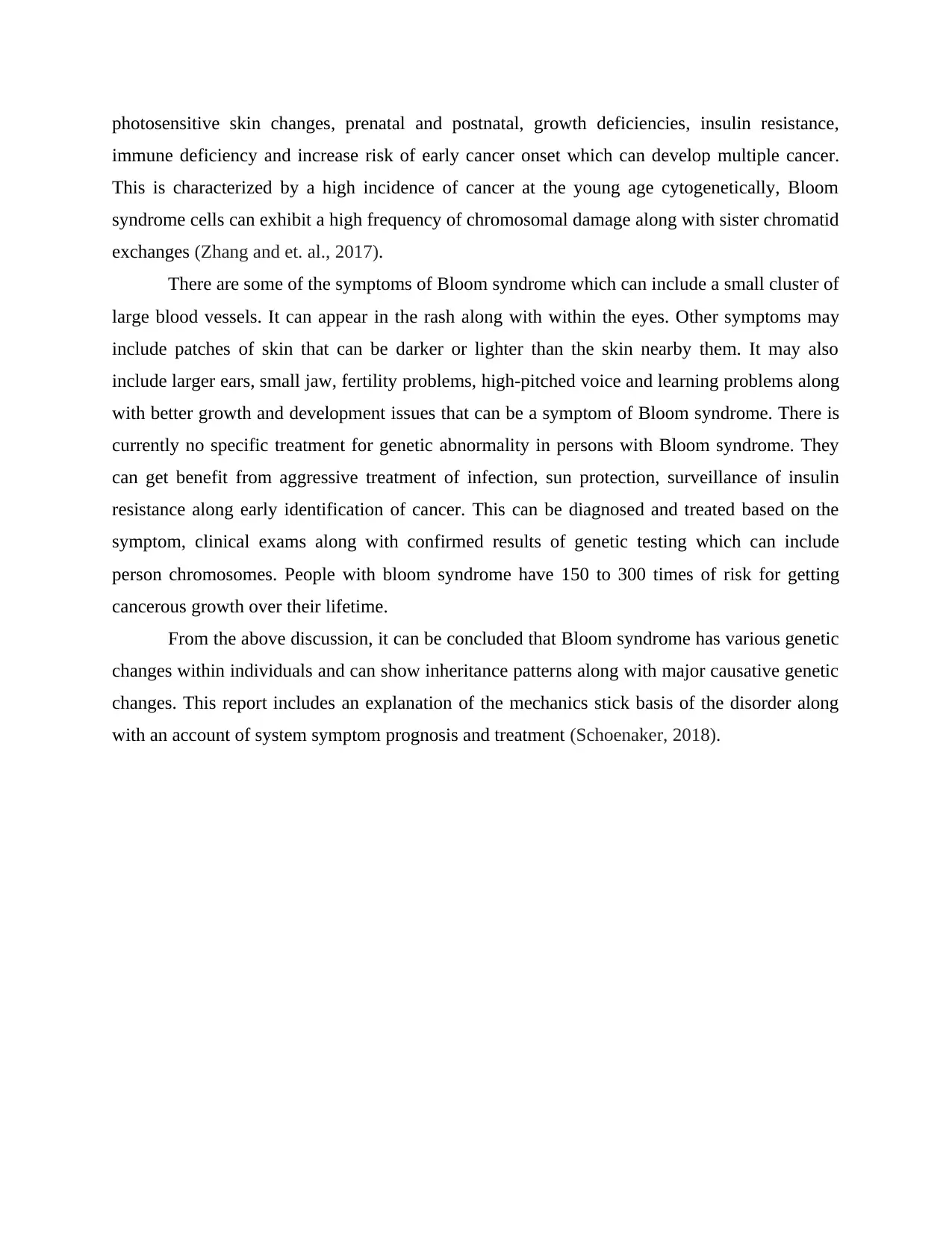
photosensitive skin changes, prenatal and postnatal, growth deficiencies, insulin resistance,
immune deficiency and increase risk of early cancer onset which can develop multiple cancer.
This is characterized by a high incidence of cancer at the young age cytogenetically, Bloom
syndrome cells can exhibit a high frequency of chromosomal damage along with sister chromatid
exchanges (Zhang and et. al., 2017).
There are some of the symptoms of Bloom syndrome which can include a small cluster of
large blood vessels. It can appear in the rash along with within the eyes. Other symptoms may
include patches of skin that can be darker or lighter than the skin nearby them. It may also
include larger ears, small jaw, fertility problems, high-pitched voice and learning problems along
with better growth and development issues that can be a symptom of Bloom syndrome. There is
currently no specific treatment for genetic abnormality in persons with Bloom syndrome. They
can get benefit from aggressive treatment of infection, sun protection, surveillance of insulin
resistance along early identification of cancer. This can be diagnosed and treated based on the
symptom, clinical exams along with confirmed results of genetic testing which can include
person chromosomes. People with bloom syndrome have 150 to 300 times of risk for getting
cancerous growth over their lifetime.
From the above discussion, it can be concluded that Bloom syndrome has various genetic
changes within individuals and can show inheritance patterns along with major causative genetic
changes. This report includes an explanation of the mechanics stick basis of the disorder along
with an account of system symptom prognosis and treatment (Schoenaker, 2018).
immune deficiency and increase risk of early cancer onset which can develop multiple cancer.
This is characterized by a high incidence of cancer at the young age cytogenetically, Bloom
syndrome cells can exhibit a high frequency of chromosomal damage along with sister chromatid
exchanges (Zhang and et. al., 2017).
There are some of the symptoms of Bloom syndrome which can include a small cluster of
large blood vessels. It can appear in the rash along with within the eyes. Other symptoms may
include patches of skin that can be darker or lighter than the skin nearby them. It may also
include larger ears, small jaw, fertility problems, high-pitched voice and learning problems along
with better growth and development issues that can be a symptom of Bloom syndrome. There is
currently no specific treatment for genetic abnormality in persons with Bloom syndrome. They
can get benefit from aggressive treatment of infection, sun protection, surveillance of insulin
resistance along early identification of cancer. This can be diagnosed and treated based on the
symptom, clinical exams along with confirmed results of genetic testing which can include
person chromosomes. People with bloom syndrome have 150 to 300 times of risk for getting
cancerous growth over their lifetime.
From the above discussion, it can be concluded that Bloom syndrome has various genetic
changes within individuals and can show inheritance patterns along with major causative genetic
changes. This report includes an explanation of the mechanics stick basis of the disorder along
with an account of system symptom prognosis and treatment (Schoenaker, 2018).
Paraphrase This Document
Need a fresh take? Get an instant paraphrase of this document with our AI Paraphraser
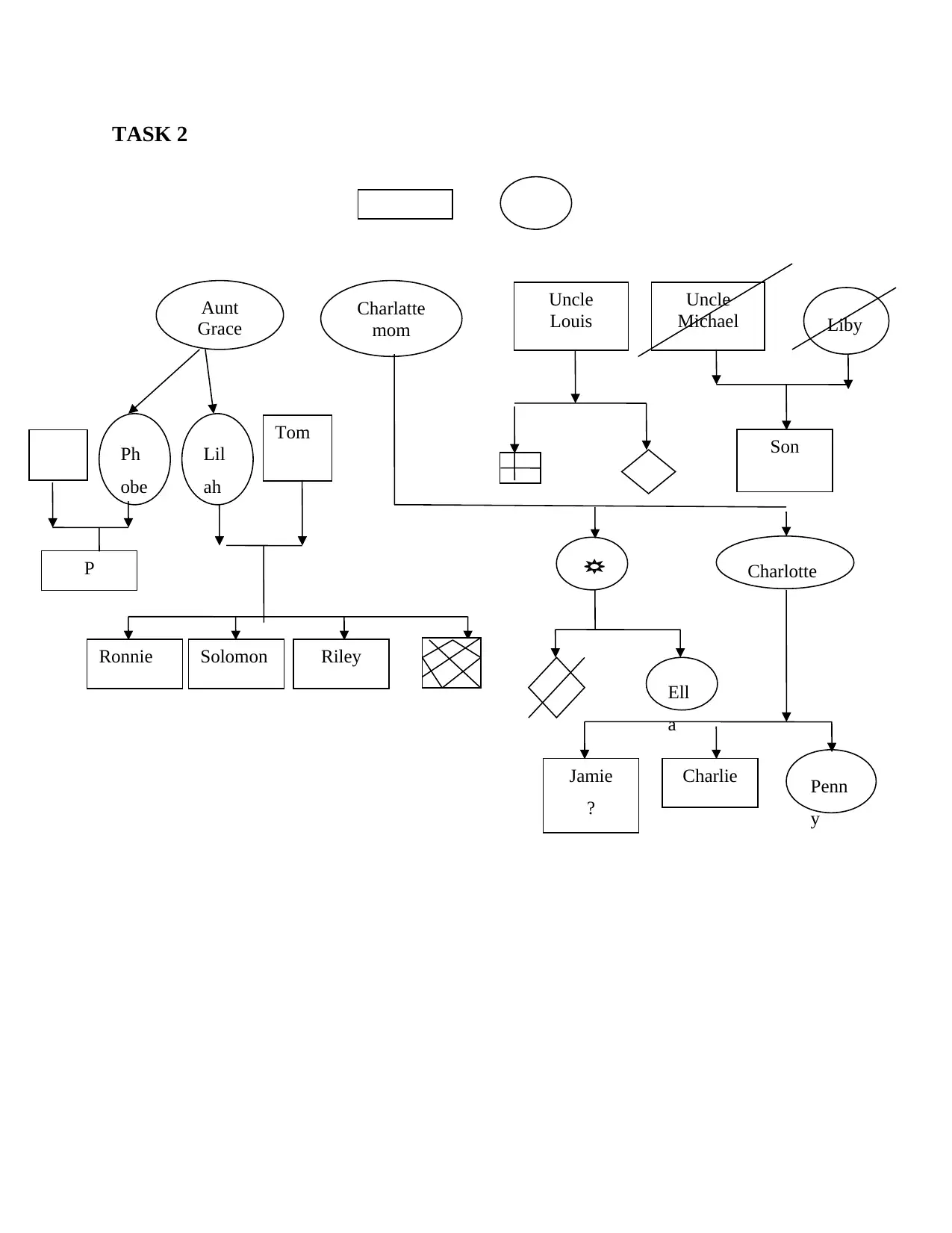
TASK 2
Uncle
Louis
Uncle
Michael
Tom
P
Ronnie Solomon Riley
Aunt
Grace
Charlatte
mom
Ph
obe
Lil
ah
Liby
Charlotte
Son
CharlieJamie
?
Penn
y
Ell
a
Uncle
Louis
Uncle
Michael
Tom
P
Ronnie Solomon Riley
Aunt
Grace
Charlatte
mom
Ph
obe
Lil
ah
Liby
Charlotte
Son
CharlieJamie
?
Penn
y
Ell
a
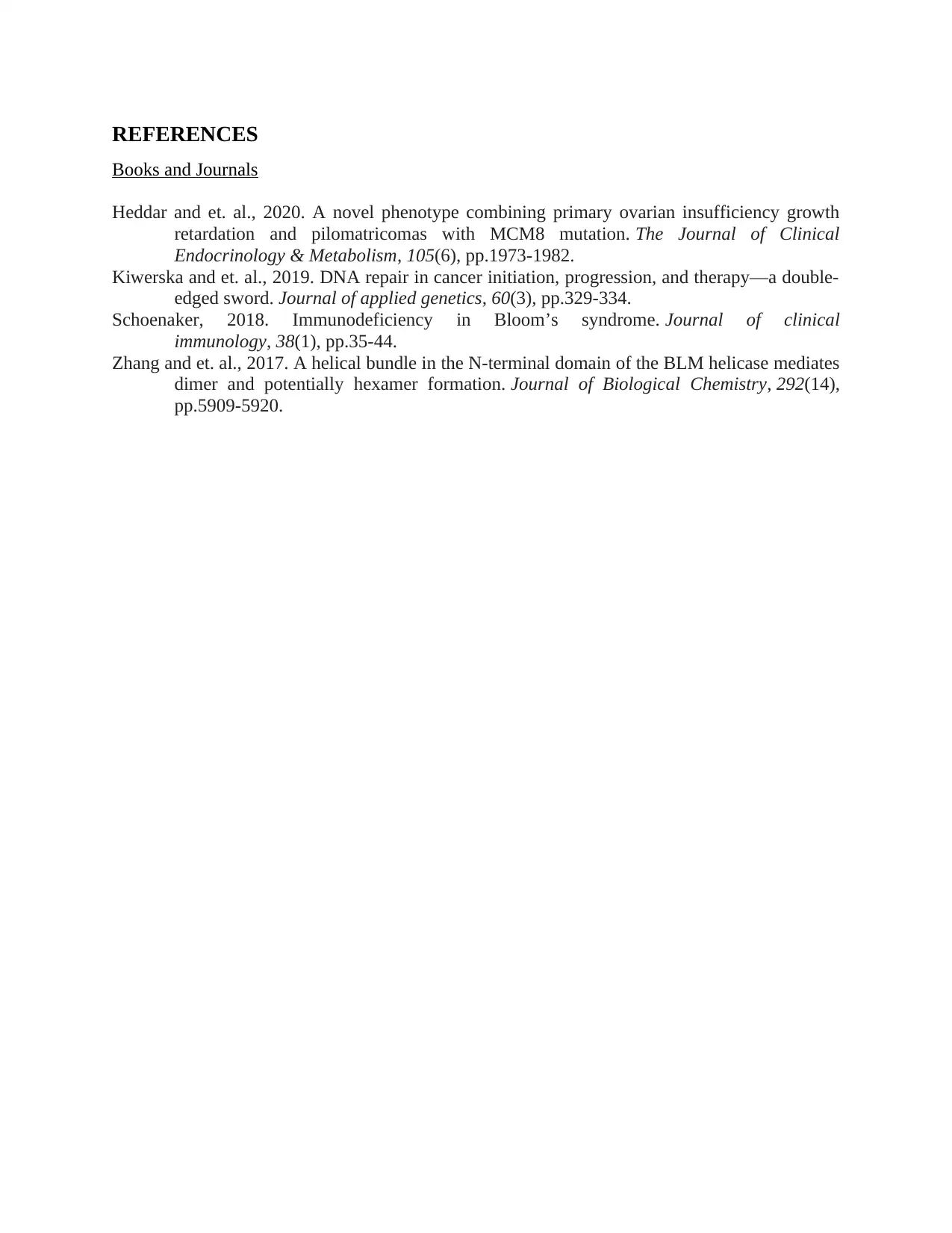
REFERENCES
Books and Journals
Heddar and et. al., 2020. A novel phenotype combining primary ovarian insufficiency growth
retardation and pilomatricomas with MCM8 mutation. The Journal of Clinical
Endocrinology & Metabolism, 105(6), pp.1973-1982.
Kiwerska and et. al., 2019. DNA repair in cancer initiation, progression, and therapy—a double-
edged sword. Journal of applied genetics, 60(3), pp.329-334.
Schoenaker, 2018. Immunodeficiency in Bloom’s syndrome. Journal of clinical
immunology, 38(1), pp.35-44.
Zhang and et. al., 2017. A helical bundle in the N-terminal domain of the BLM helicase mediates
dimer and potentially hexamer formation. Journal of Biological Chemistry, 292(14),
pp.5909-5920.
Books and Journals
Heddar and et. al., 2020. A novel phenotype combining primary ovarian insufficiency growth
retardation and pilomatricomas with MCM8 mutation. The Journal of Clinical
Endocrinology & Metabolism, 105(6), pp.1973-1982.
Kiwerska and et. al., 2019. DNA repair in cancer initiation, progression, and therapy—a double-
edged sword. Journal of applied genetics, 60(3), pp.329-334.
Schoenaker, 2018. Immunodeficiency in Bloom’s syndrome. Journal of clinical
immunology, 38(1), pp.35-44.
Zhang and et. al., 2017. A helical bundle in the N-terminal domain of the BLM helicase mediates
dimer and potentially hexamer formation. Journal of Biological Chemistry, 292(14),
pp.5909-5920.
⊘ This is a preview!⊘
Do you want full access?
Subscribe today to unlock all pages.

Trusted by 1+ million students worldwide
1 out of 6
Related Documents
Your All-in-One AI-Powered Toolkit for Academic Success.
+13062052269
info@desklib.com
Available 24*7 on WhatsApp / Email
![[object Object]](/_next/static/media/star-bottom.7253800d.svg)
Unlock your academic potential
Copyright © 2020–2025 A2Z Services. All Rights Reserved. Developed and managed by ZUCOL.





